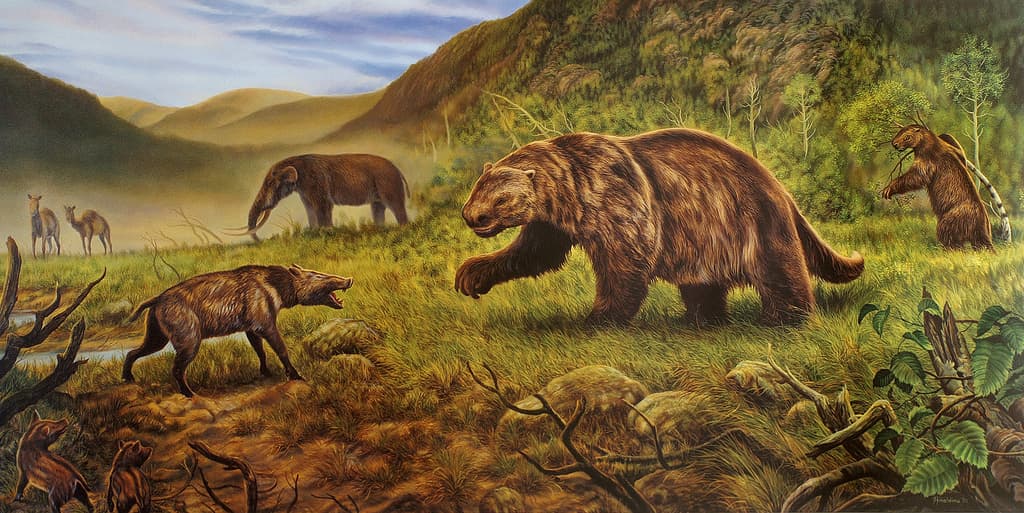Not so long ago, at the end of the last ice age, the Earth was full of large animals – mammoths, mastodons, giant ground sloths, and giant rodents. Then they suddenly disappeared. Now researchers have found that they were wiped out by humans.
In total, 46 species of large land-dwelling mammals – species weighing 1,000 kilos or more – disappeared from the Earth's surface over the past 50,000 years. In Europe, North America, South America, Australia, and northern Asia, it became eerily empty – no giant animals were left after the extinction.
Only in Africa and southern Asia did smaller remnants of the megafauna manage to survive – a total of eleven species – including the present-day elephants and rhinos.
Among the extinct species are twelve elephant-like animals: mammoths, mastodons, stegodons, gomphotheres, and others. Four rhino species died out, as did the massive toxodons in South America and the giant camel Camelops in North America.
Perhaps most remarkable among the wiped-out giants were the giant ground sloths in North and South America, a total of 16 species of gigantic, ground-dwelling relatives of the present-day sloths. Additionally, four species of giant armadillos, also from North and South America, disappeared. They were heavily armored and could weigh two tons, more than a Volkswagen Beetle.
Sabertoothed Cats
But the mass extinction did not only affect species weighing a ton or more. Species weighing 50 kilos or more also took an exceptionally hard hit, including several horse-like animals, camels, and oxen, as well as the enormous giant deer in Europe. A long list of large predators also died out, including all sabertoothed cats, the giant lion, the American lion, the terror wolf, and the massive short-nosed bear.
In total, 161 species of large mammals died out on Earth during this geologically short period. It lasted for around 40,000 years and was, in principle, completed 10,000 years ago at the end of the last ice age.
What happened? Researchers have debated the problem for over 200 years without being able to agree, but two hypotheses have been dominant. Either the megafauna was wiped out by climate change, or – which has been controversial – humans, the Ice Age hunters, were responsible.
Some researchers have been reluctant to point out our own species, our own ancestors. It is not possible, they argue, that a few thousand humans armed with spears could have had such a devastating effect on the fauna. Moreover, there are not particularly many archaeological traces of that type of hunting.
Humans Responsible
But in a new study in the scientific journal Extinction, researchers led by Danish biologist Jens-Christian Svenning at the University of Aarhus have compiled all available facts on the subject and concluded that climate change must be ruled out as a factor. Humans were largely responsible for the mass extinction. Paleontologist Lars Werdelin at the National Museum in Stockholm thinks the compilation is quite convincing:
I have always advocated that the extinction was due to multiple causes, but now I am leaning more towards humans being the main factor, he says.
The fact that there are not particularly many traces of human hunting is no argument. Such traces are always rare.
The extinction occurred at different times on different continents, in Australia around 50,000 years ago, and in Europe and northern Asia over a longer period from 50,000 to 10,000 years ago – although the woolly mammoth lived on until 4,000 years ago on Wrangel Island. In North America, the extinction occurred with sudden abruptness starting 14,000 years ago, and then spread to South America where the last giant animals disappeared 7,000 years ago.
During this period, the climate changed dramatically. Large inland ice sheets covered parts of the northern hemisphere, followed by periods of warmer climate. But the extinction does not follow the climate changes. And the changes were just as dramatic at earlier stages during the ice age – without causing any extinctions.
Ecological Disaster
The most convincing evidence that humans were ultimately responsible is the selectivity of the extinction. No small mammals died out, only the large species – the ones that were huntable.
Tellingly, the disappearance of the animals coincides with the modern human, Homo sapiens, invading the different continents. Our species originated in Africa and spread to southern Asia and Australia 60,000–50,000 years ago. Northern Eurasia was conquered somewhat later, and even later, around 20,000 years ago, humans arrived in western hemisphere. The extinction generally occurred shortly after humans arrived.
The study notes that the loss of megafauna must have had significant ecological consequences, as large mammals play a central role in shaping vegetation structure, seed dispersal, and nutrient cycling.
It's not just about killing. Humans started fires and had a significant impact on vegetation. The flora changed, which in turn changed the fauna, says Werdelin.
In contrast to other continents, large parts of the megafauna survived in Africa, including the present-day elephants and rhinos. The reason is believed to be that humans originated in Africa, and the fauna on the continent thus had time to adapt gradually to the new dangerous predator.
On other continents, however, the animals had no opportunity for such adaptation. But interestingly, humans had a negative impact on the African fauna at an earlier point in history. It was when the Homo genus began to develop towards larger species two million years ago, and Homo erectus emerged on the scene. Apparently, the species competed out the sabertoothed cats in Africa, leading to their extinction 1.5 million years ago from the continent, much earlier than on other continents.
Source: Ecology Letters
The Ice Age, Pleistocene, is the name of a series of glaciations, interrupted by shorter warm periods, interglacials, which began 2.58 million years ago and is still ongoing. In popular parlance, however, "the Ice Age" refers only to the most recent glaciation, which began 115,000 years ago and ended 11,700 years ago when the current interglacial began.
The last Ice Age is not the only one in Earth's history. At least four times, large parts of the globe have been covered by massive ice sheets.
Source: Journal of Quaternary Science





